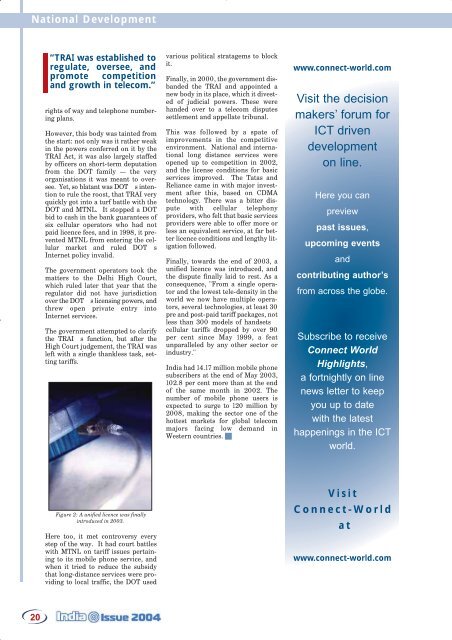Contents - Connect-World
Contents - Connect-World
Contents - Connect-World
You also want an ePaper? Increase the reach of your titles
YUMPU automatically turns print PDFs into web optimized ePapers that Google loves.
National Development<br />
“TRAI was established to<br />
regulate, oversee, and<br />
promote competition<br />
and growth in telecom.”<br />
rights of way and telephone numbering<br />
plans.<br />
However, this body was tainted from<br />
the start: not only was it rather weak<br />
in the powers conferred on it by the<br />
TRAI Act, it was also largely staffed<br />
by officers on short-term deputation<br />
from the DOT family — the very<br />
organisations it was meant to oversee.<br />
Yet, so blatant was DOTs intention<br />
to rule the roost, that TRAI very<br />
quickly got into a turf battle with the<br />
DOT and MTNL. It stopped a DOT<br />
bid to cash in the bank guarantees of<br />
six cellular operators who had not<br />
paid licence fees, and in 1998, it prevented<br />
MTNL from entering the cellular<br />
market and ruled DOTs<br />
Internet policy invalid.<br />
The government operators took the<br />
matters to the Delhi High Court,<br />
which ruled later that year that the<br />
regulator did not have jurisdiction<br />
over the DOTs licensing powers, and<br />
threw open private entry into<br />
Internet services.<br />
The government attempted to clarify<br />
the TRAIs function, but after the<br />
High Court judgement, the TRAI was<br />
left with a single thankless task, setting<br />
tariffs.<br />
various political stratagems to block<br />
it.<br />
Finally, in 2000, the government disbanded<br />
the TRAI and appointed a<br />
new body in its place, which it divested<br />
of judicial powers. These were<br />
handed over to a telecom disputes<br />
settlement and appellate tribunal.<br />
This was followed by a spate of<br />
improvements in the competitive<br />
environment. National and international<br />
long distance services were<br />
opened up to competition in 2002,<br />
and the license conditions for basic<br />
services improved. The Tatas and<br />
Reliance came in with major investment<br />
after this, based on CDMA<br />
technology. There was a bitter dispute<br />
with cellular telephony<br />
providers, who felt that basic services<br />
providers were able to offer more or<br />
less an equivalent service, at far better<br />
licence conditions and lengthy litigation<br />
followed.<br />
Finally, towards the end of 2003, a<br />
unified licence was introduced, and<br />
the dispute finally laid to rest. As a<br />
consequence, "From a single operator<br />
and the lowest tele-density in the<br />
world we now have multiple operators,<br />
several technologies, at least 30<br />
pre and post-paid tariff packages, not<br />
less than 300 models of handsets<br />
cellular tariffs dropped by over 90<br />
per cent since May 1999, a feat<br />
unparalleled by any other sector or<br />
industry."<br />
India had 14.17 million mobile phone<br />
subscribers at the end of May 2003,<br />
102.8 per cent more than at the end<br />
of the same month in 2002. The<br />
number of mobile phone users is<br />
expected to surge to 120 million by<br />
2008, making the sector one of the<br />
hottest markets for global telecom<br />
majors facing low demand in<br />
Western countries. <br />
www.connect-world.com<br />
Visit the decision<br />
makers’ forum for<br />
ICT driven<br />
development<br />
on line.<br />
Here you can<br />
preview<br />
past issues,<br />
upcoming events<br />
and<br />
contributing author’s<br />
from across the globe.<br />
Subscribe to receive<br />
<strong>Connect</strong> <strong>World</strong><br />
Highlights,<br />
a fortnightly on line<br />
news letter to keep<br />
you up to date<br />
with the latest<br />
happenings in the ICT<br />
world.<br />
Figure 2: A unified licence was finally<br />
introduced in 2003.<br />
Here too, it met controversy every<br />
step of the way. It had court battles<br />
with MTNL on tariff issues pertaining<br />
to its mobile phone service, and<br />
when it tried to reduce the subsidy<br />
that long-distance services were providing<br />
to local traffic, the DOT used<br />
Visit<br />
<strong>Connect</strong>-<strong>World</strong><br />
at<br />
www.connect-world.com<br />
20
















